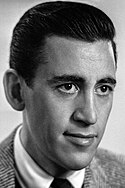J.D. Salinger Quote
What gets me about D.B., though, he hated the war so much, and yet he got me to read this book A Farewell to Arms last summer. He said it was so terrific. That's what I can't understand. It had this guy in it named Lieutenant Henry that was supposed to be a nice guy and all. I don't see how D.B. could hate the Army and war and all so much and still like a phony like that. I mean, for instance, I don't see how he could like a phony like that and still like that one by Ring Lardner, or that other one he's so crazy about, The Great Gatsby. D.B. got sore when I said that, and said I was too young and all to appreciate it, but I don't think so. I told him I liked Ring Lardner and The Great Gatsby and all. I did, too. I was crazy about The Great Gatsby. Old Gatsby. Old sport. That killed me.
What gets me about D.B., though, he hated the war so much, and yet he got me to read this book A Farewell to Arms last summer. He said it was so terrific. That's what I can't understand. It had this guy in it named Lieutenant Henry that was supposed to be a nice guy and all. I don't see how D.B. could hate the Army and war and all so much and still like a phony like that. I mean, for instance, I don't see how he could like a phony like that and still like that one by Ring Lardner, or that other one he's so crazy about, The Great Gatsby. D.B. got sore when I said that, and said I was too young and all to appreciate it, but I don't think so. I told him I liked Ring Lardner and The Great Gatsby and all. I did, too. I was crazy about The Great Gatsby. Old Gatsby. Old sport. That killed me.
Related Quotes
For everything in this journey of life we are on, there is a right wing and a left wing: for the wing of love there is anger; for the wing of destiny there is fear; for the wing of pain there is heali...
About J.D. Salinger
The Catcher in the Rye (1951) was an immediate popular success; Salinger's depiction of adolescent alienation and loss of innocence was influential, especially among adolescent readers. The novel was widely read and controversial, and its success led to public attention and scrutiny. Salinger became reclusive, publishing less frequently. He followed Catcher with a short story collection, Nine Stories (1953); Franny and Zooey (1961), a volume containing a novella and a short story; and a volume containing two novellas, Raise High the Roof Beam, Carpenters and Seymour: An Introduction (1963). Salinger's last published work, the novella Hapworth 16, 1924, appeared in The New Yorker on June 19, 1965.
Afterward, Salinger struggled with unwanted attention, including a legal battle in the 1980s with biographer Ian Hamilton and the release in the late 1990s of memoirs written by two people close to him: Joyce Maynard, an ex-lover; and his daughter, Margaret Salinger.
